Up, Up and Away!
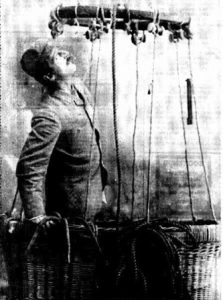
Studio portrait of Harry Henden in The Gem, 1885, complete with grapnel, tackle, thermometer and timepiece. From The Canberra Times 14 January 1984 p.15
https://trove.nla.gov.au/newspaper/article/116384358
Several extraordinary, but largely unknown, feats of aeronautics took place in our local skies during the 1880s.
Sydney had already seen, largely unsuccessful, balloon spectacles during the 1850s, 60s and 70s. Competition between budding enthusiasts was fierce with newspapers carrying advertisements and reports of their daring exploits.
But by 1884 Sydneysiders were just a little jaded:
‘Balloon ascents in Sydney have in the past been attended with so much want of skill and consequent misfortune that a thoroughly successful ascent is quite an exception to what has come to be looked upon as the rule in connection with such trips.’[1]
Harry Henden, an English aeronaut from Kent, arrived in Sydney aboard the Lusitania in November 1884. He was accompanied by his wife and five young children – and a hot-air balloon named The Gem. A watchmaker, jeweller and bell-ringer, Henden had already made more than 200 successful ascents throughout England, Wales, Ireland and Germany. Within a fortnight he was advertising his spectacular shows in the newspapers and crowds flocked to see him.
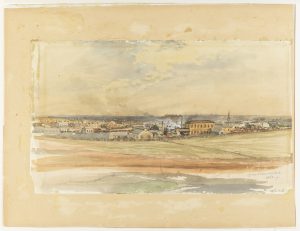
From Prince Alfred Park, 1868-69 by Samuel Elyard. Courtesy State Library of NSW
In early December he made several ascents from Prince Alfred Park near Central Railway Station. During his first, on Saturday 6 December:
‘A cheer was given as the aeronaut went off, clinging to the ropes of the car and waving his hat. The thousands of upturned faces watching the ascent presented a strange spectacle, and until the balloon descended groups of men, women and children in every street could be seen gazing at the tiny globe suspended in the clear blue sky.’[2]
‘The balloon travelled some distance and hovered for some time over Rookwood Cemetery ‘the name “Gem” being distinctly visible to the onlookers at the Rookwood Railway Station.’[3]
On that occasion he ‘landed about two miles beyond Enfield, in the direction of Rookwood Cemetery.’[4] Spying ‘an open space in the centre of what appeared to be a wood’ [5] he threw out the grapnel, which caught in the stump of a tree and ensured a safe landing. It’s likely that this was in the vicinity of today’s Strathfield Golf Course. Henden was greeted by several bemused Chinese men, who had known nothing of the spectacle, quickly followed by horsemen and buggies who had been following his flight as best they could from the ground.
‘The balloon was without a scratch, and was speedily emptied, packed in a cart, and driven into town.’[6]
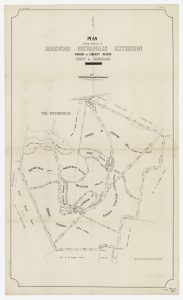
Plan showing subdivision of Rookwood Necropolis extension, 1891. Courtesy State Library of NSW
On Monday 8 December Henden repeated his ascent from Prince Alfred Park with a crowd of 4000 people in attendance. The aeronaut had received a telegram from the Government astronomer, Mr Russell, with details of the prevailing currents.
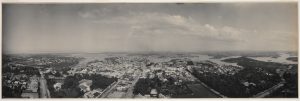
Panorama of Sydney from a balloon, 1904 by Melvin Vaniman. Courtesy State Library of NSW
The Sydney Morning Herald reported on the event:
‘The greatest altitude attained by the aeronaut was 8000 feet. After passing through 2000 feet of clouds Mr Henden states that nothing but a beautiful clear blue sky was visible, but being unable to tell exactly what course he was travelling, and being afraid of getting out to sea, he was compelled to open the valve in order to descend through the clouds again… After descending through the clouds the course taken by the balloon was towards Rookwood, at which place the balloon descended at about ten minutes to 6 o’clock, between the cemetery and the station. The distance covered was 11 miles, and this was accomplished within the hour.’[7]
Rookwood Cemetery has expanded significantly over many years, so this would possibly place Henden’s landing on ground now part of the cemetery, near the railway line. Lidcombe Station was once known as Rookwood, although it had originally been opened as Haslam’s Creek Station in 1858.
Exactly four years later, on 8 December 1888, the first planned Australian free-fall parachute descent took place over Homebush. Aeronaut, athlete, gymnast and watchmaker, John Thomas Williams borrowed The Gem from Harry Henden and ascended about 8000 feet from Ashfield Recreation Grounds – now Hammond Park.[8] Incredibly, by his own admission, Williams had never been up in a balloon before. Nor had he ever descended with a parachute![9] The parachute was of his own design,[10] constructed of Chinese silk[11] and later patented.[12] The event was advertised in the press:
‘Mr J.T. Williams the Australian aeronaut will give his daring aeriel [sic] scientific feat of ascending with a balloon, without a car, straight into the clouds. J.T. Williams then leaves his balloon, and jumps into space, and descends, hanging by his hands to his parachute and returns to the ground with perfect safety.’[13]
A bold claim. With so little real experience, spectators were a little doubtful.
‘The majority of the public looked upon him as a foolish adventurer, and this doubtless had much to do with the poor attendance at the place where this sensational feat was to be attempted.’[14]
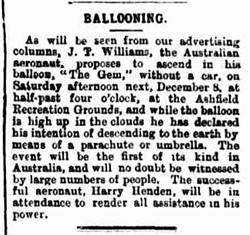
The Australian Star 4 December 1888 p.5 https://trove.nla.gov.au/newspaper/article/228423993
Not everything went to plan. Two men were overcome by the gas while the balloon was being filled but later recovered.[15] Although reluctant to part with their money at the recreation grounds, thousands of spectators gathered to view his ascent from vantage points throughout the district. Dispensing with the traditional ‘cart’ or ‘basket’, Williams attached his parachute to the net of the balloon with a piece of silk. He then positioned himself on a sling in place of the ‘cart.’[16]
At 6pm, amidst cheers and excitement, the balloon commenced its ascent.
‘A rather strong wind sent the balloon for a short distance towards Croydon and then she rose like a a skylark. Upward, onward she went, Mr Williams holding on to the ring by one hand and waving his cap with the other till his form could hardly be distinguished, for this fearless fellow had entirely discarded the usual cage, saying he felt not the slightest fear. In a few seconds the balloon looked like a small bird flying high amongst the clouds, the wind still carrying it towards Parramatta. But suddenly it stopped, apparently when over Homebush…’[17]
The Brisbane Courier reported:
‘Though he had never been in a balloon before he felt he could have done any kind of gymnastics up in the air, but he contented himself with studying his parachute and thinking how it could be improved. When he left the balloon he said he must have fallen fully 100ft before the parachute opened, but afterwards he had it perfectly under control and steered it beautifully.’[18]
Between Burwood and Strathfield he was seen to drop although the balloon drifted in the opposite direction, finally landing at Greenwich. The intrepid aeronaut landed in a paddock near the Wentworth Hotel at Homebush West, just nine minutes after first ascending at Ashfield.
‘When he reached earth between Homebush and Flemington in a grass paddock – three miles as the crow flies from where he ascended – without any shock, and folded up his parachute, he walked to the cab which had been sent up for him.’[19]
The cab took him back to Ashfield,[20] his only disappointment being that the crowds of doubtful well-wishers there had not been able to see him land.
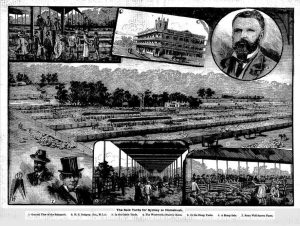
These illustrations show the Wentworth Hotel and nearby saleyards at Homebush West in 1884, close to Williams’ landing site.
Australian Town and Country Journal 2 August 1884 p.26
Just a few months later, during April 1889, rope-walker, ‘Professor’ Jackson attempted to emulate Williams’ feat in The Gem, again borrowed from Henden, with an ascent from Ashfield. He landed heavily, but safely, in a backyard in Devonshire Street, Croydon.[21] Sadly, The Gem was blown out to sea and wrecked. The loss of his balloon effectively ended Henden’s career as a balloonist. However, he had settled in Orange, running a successful watchmakers and jewellery business for 47 years. He died there, aged almost 90, in April 1937.
Williams went on to make another ascent from Ashfield on 12 February 1890. On this occasion, from the incredible height of 20,000 feet over Kogarah, he was forced to bail out, landing in the Georges River near Blakehurst.[22]
Williams’ fate is somewhat more obscure than Henden’s, although it seems likely that he was the John Thomas Williams who died at RPA Hospital on 10 July 1916 and was buried at Rookwood.
Although none of these men are household names, their extraordinary aeronautical feats deserve to be remembered.
By J.J. MacRitchie
Local Studies Advisor
References
[1] Goulburn Evening Penny Post 13 December 1884 p.7 https://trove.nla.gov.au/newspaper/article/98434861[2] The Sydney Mail and New South Wales Advertiser 13 December 1884 p.1209 https://trove.nla.gov.au/newspaper/article/163272754
[3] The Albury Banner and Wodonga Express 12 December 1884 p.19 https://trove.nla.gov.au/newspaper/article/254378936
[4] The Sydney Mail and New South Wales Advertiser 13 December 1884 p.1209 https://trove.nla.gov.au/newspaper/article/163272754
[5] Goulburn Evening Penny Post 13 December 1884 p.7 https://trove.nla.gov.au/newspaper/article/98434861
[6] Goulburn Evening Penny Post 13 December 1884 p.7 https://trove.nla.gov.au/newspaper/article/98434861
[7] The Sydney Morning Herald 9 December 1884 p.10 https://trove.nla.gov.au/newspaper/article/13586196
[8] The Canberra Times 14 January 1984 p.15 https://trove.nla.gov.au/newspaper/article/116384358
[9] South Australian Weekly Chronicle 15 December 1888 p.11 https://trove.nla.gov.au/newspaper/article/94766669
[10] The Australian Star 10 December 1888 p.8 https://trove.nla.gov.au/newspaper/article/228420986
[11] Evening News 10 December 1888 p.5 https://trove.nla.gov.au/newspaper/article/108118685
[12] Daily Telegraph 23 April 1889 p.6 https://trove.nla.gov.au/newspaper/article/235869482
[13] Evening News 5 December 1888 p.1 https://trove.nla.gov.au/newspaper/article/108110346
[14] South Australian Weekly Chronicle 15 December 1888 p.11 https://trove.nla.gov.au/newspaper/article/94766669
[15] The Age (Melbourne) 10 December 1888 p.6 https://trove.nla.gov.au/newspaper/article/193401053
[16] Mines, Frank ‘Draft History of Parachuting in Australia’ https://www.apf.com.au/APF-Zone/APF-Information/History-of-the-APF/Draft-History-of-Parachuting-in-Australia/default.aspx#Ballooning_In_Australia.
[17] South Australian Weekly Chronicle 15 December 1888 p.11 https://trove.nla.gov.au/newspaper/article/94766669
[18] The Brisbane Courier 13 December 1888 p.3 https://trove.nla.gov.au/newspaper/article/3489887
[19] The Brisbane Courier 13 December 1888 p.3 https://trove.nla.gov.au/newspaper/article/3489887
[20] The Capricornian 22 December 1888 p.11 https://trove.nla.gov.au/newspaper/article/65793615
[21] Australian Town and Country Journal 27 April 1889 p.19 https://trove.nla.gov.au/newspaper/article/71117837
[22] ‘Williams the balloonist’ https://georgesriverlocalstudies.home.blog/2019/07/16/williams-the-balloonist/

2 Comments. Leave new
Many thanks for this interesting, well-researched story of the exploits of my great grandfather, Harry Henden!
Thanks so much for getting in touch, Bob. I really enjoyed researching this wonderful story. What an amazing man your great-grandfather was!